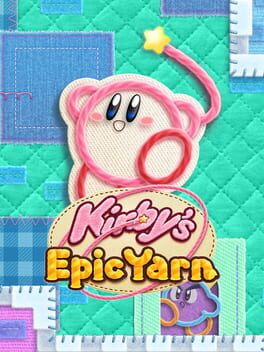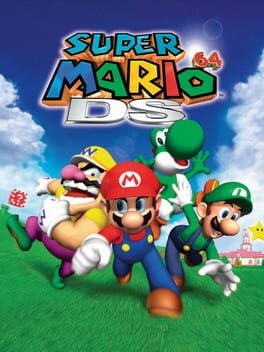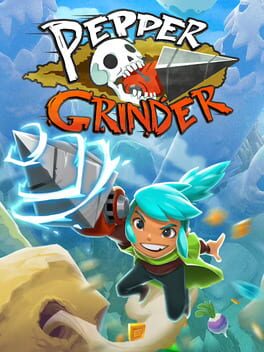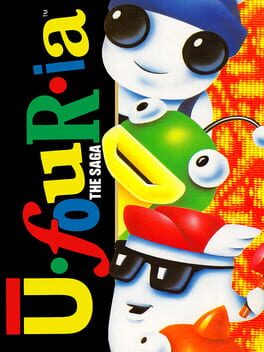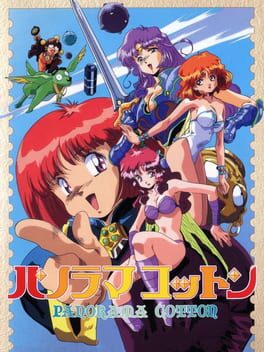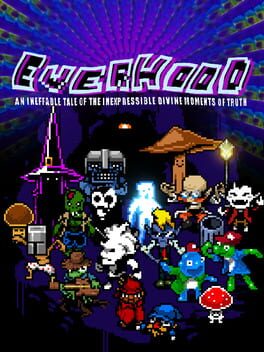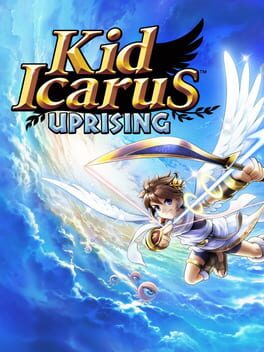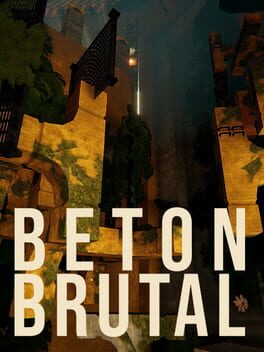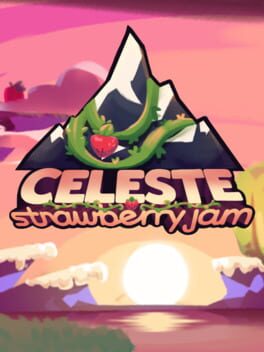Lozicle
103 Reviews liked by Lozicle
Kirby's Epic Yarn
2010
Super Mario 64 DS
2004
nintendo salvaging the american gaming market with the release of the NES was the modern inflection point for our industry, in some ways that are less obvious than others. the console enshrined gaming as a medium with legitimacy beyond the original fad-like relevance of the atari VCS, but the centralization of this success around nintendo gave the company an uncomfortable amount of leverage. this immediately portended poorly with the simultaneous release of the console's killer app: super mario bros., which gestured to a sinister rejection of the console's original intent. look to the japanese launch line-up and you'll see arcade staples such as donkey kong and popeye; games that lauded precise, restricted play with definitive rules and short runtimes. super mario bros. was a refutation of this design philosophy in favor of the loosey-goosey variable jump heights, frequent health restoration items, and long hallways of copy-paste content replacing the tightly paced experiences that defined the era before. the NES still featured arguably the greatest console expressions of the rigorous arcade action experiences that defined the '80s - castlevania, ninja gaiden, and the early mega mans all come to mind - but the seeds super mario bros. planted would presage a shift into more and more experiences that coddled the player rather than testing their fortitude. in some ways, super mario bros. lit the match that would leave our gaming landscape in the smoldering ruins of the AAA design philosophy.
the '90s only deepened nintendo's exploration of trends that would further attempt to curb the arcade philosophy, which still floated on thanks to the valiant efforts of their competitors at sega, capcom, konami, and others. super mario world kicked off nintendo's 16-bit era with an explicitly non-linear world map that favored the illusion of charting unknown lands over the concrete reality of learning play fundamentals, and its pseudo-sequel yoshi's island would further de-emphasize actual platforming chops by giving the player a generous hover and grading them on their ability to pixel hunt for collectables rather than play well, but the most stunning example of nintendo's decadence in this era is undoubtedly donkey kong '94. the original donkey kong had four levels tightly wound around a fixed jump arc and limited ability for mario to deal with obstacles; its ostensible "remake" shat all over its legacy by infusing mario's toolkit with such ridiculous pablum such as exaggerated flip jumps, handstands, and other such acrobatics. by this point nintendo was engaging in blatant historical revisionism, turning this cornerstone of the genre into a bug-eyed circus romp, stuffed with dozens of new puzzle-centric levels that completely jettisoned any semblance of toolkit-oriented level design from the original game. and yet, this was the final fissure before the dam fully burst in 1996.
with the release of the nintendo 64 came the death knell of the industry: the analog stick. nintendo's most cunning engineers and depraved designers had cooked up a new way to hand unprecedented control to the player and tear down all obstacles standing in the way of the paternalistic head-pat of a "job well done" that came with finishing a game. with it also came this demonic interloper's physical vessel, super mario 64; the refined, sneering coalescence of all of nintendo's design tendencies up to this point. see here a game with enormous, previously unfathomable player expression, with virtually every objective solvable in myriad different ways to accommodate those who refuse to engage with the essential challenges the game offers. too lazy to even attempt some challenges at all? feel free to skip over a third of the game's "star" objectives on your way to the final boss; you can almost see the designers snickering as they copy-pasted objectives left and right, knowing that the majority of their player base would never even catch them in the act due to their zombie-like waddle to the atrociously easy finish line. even as arcade games stood proud at the apex of the early 3D era, super mario 64 pulled the ground out underneath them, leaving millions of gamers flocking to similar experiences bereft of the true game design fundamentals that had existed since the origination of the medium.
this context is long but hopefully sobering to you, the reader, likely a gamer so inoculated by the drip-feed of modern AAA slop that you likely have regarded super mario 64 as a milestone in 3D design up to now. yet, it also serves as a stark contrast to super mario 64 ds, a revelation and admission of guilt by nintendo a decade after their donkey kong remake plunged modern platformers into oblivion.
the d-pad alone is cool water against the brow of one in the throes of a desert of permissive design techniques. tightening up the input space from the shallow dazzle of an analog surface to the limitations of eight directions instantly reframes the way one looks at the open environments of the original super mario 64. sure, there's a touch screen option, but the awkward translation of a stick to the literal flat surface of the screen seems to be intentionally hobbled in order to encourage use of the d-pad. while moving in a straight line may still be simple, any sort of other action now begets a pause for reflection over the exact way one should proceed. is the sharp 45 or 90 degree turn to one side "good enough", or will I need to make a camera adjustment in-place? for this bridge, what combination of angles should I concoct in order to work through this section? the removal of analog control also forces the addition of an extra button to differentiate between running and walking, slapping the player on the wrist if they try to gently segue between the two states as in the original. the precision rewards those who aim to learn their way around the rapid shifts in speed while punishing those who hope they can squeak by with the same sloppy handling that the original game allowed.
on its own this change is crucial, but it still doesn't cure the ills of the original's permissive objective structure. however, the remake wisely adds a new character selection system that subtly injects routing fundamentals into the game's core. for starters: each of the characters has a separate moveset, and while some characters such as yoshi and luigi regrettably have the floaty hover and scuttle that I disdained in yoshi's island, it's at least balanced here by removing other key aspects of their kit such as wall jumps and punches. the addition of wario gives the game a proper "hard mode," with wario's lumbering speed and poor jump characteristics putting much-needed limiters on the game's handling. for objectives that now explicitly require wario to complete, the game is effectively barring you from abusing the superior movement of the original game by forcing you into a much more limited toolkit with rigid d-pad controls, the kind of limitations this game absolutely needed in order to shine.
that last point about objectives that specifically require a given character is key: the remake segments its objectives based on which characters are viable to use to complete them. however, while in some cases the game may telegraph which specific characters are required for a particular task, in many cases the "correct" solution is actually to bounce between the characters in real time. this is done by strategically placing hats for each of the characters throughout the map - some attached to enemies and some free-floating - which allow the player to switch on the fly. this adds new detours to the otherwise simple objectives that vastly increases their complexity: which toolkit is best suited for which part of each mission? how should my route be planned around the level to accommodate hats I need to pick up? will I be able to defeat an enemy that's guarding the hat if I had to? this decision-making fleshes out what was previously a mindless experience.
there's one additional element to this system that truly elevates it to something resembling the arcade experiences of yore. while you can enter a level as any character, entering as yoshi allows you to preemptively don the cap of any other character as you spawn in, preventing the player from having to back-track to switch characters. on the surface this seems like another ill-advised QoL feature, but some subtle features reveal something more fascinating. yoshi has no cap associated with him, so to play as him, one must enter the level with him. however, you often need to switch to another character in the middle of a level. how do you switch back? by taking damage. to solve the ridiculously overstuffed eight piece health bar of the original, this remake transforms it into a resource you expend in order to undergo transformation. sure, one could theoretically collect coins in order to replenish this resource, but this adds a new layer onto the routing that simply didn't exist in the original game, where there were so many ways to circumvent obstacles with the permissive controls that getting hit in the first place was often harder than completing the objective. by reframing the way that the player looks at their heath gauge, the game is calling to mind classic beat 'em ups, where the health gauge often doubled as a resource to expend for powerful AoE supers.
the game still suffers from much of the rotten design at the core of its forebear; these above changes are phenomenal additions, but they're grafted onto a framework that's crumbling as you delve into it. regardless, the effort is admirable. for a brief moment, nintendo offered an apology to all of those hurt by their curbstomping of the design philosophies that springboarded them into juggernaut status in the first place, and they revitalized classic design perspectives for many millions more who first entered the world of gaming after it had already been tainted by nintendo's misdeeds. the galaxy duology, released a few years after this game, attempted to rework the series from the ground up with a new appreciation for arcade design by limiting the bloated toolkit of previous games and linearizing levels, but the damage had already been done. the modern switch era has magnified nintendo's worst tendencies, putting proper execution and mechanical comprehension to the wayside as they accelerate the disturbing "the player is always right" principles that have infested their games since that original super mario bros. by looking at super mario 64 ds in this context, we at least get a glimpse of what a better world could have looked like had nintendo listened to their elders all along.
the '90s only deepened nintendo's exploration of trends that would further attempt to curb the arcade philosophy, which still floated on thanks to the valiant efforts of their competitors at sega, capcom, konami, and others. super mario world kicked off nintendo's 16-bit era with an explicitly non-linear world map that favored the illusion of charting unknown lands over the concrete reality of learning play fundamentals, and its pseudo-sequel yoshi's island would further de-emphasize actual platforming chops by giving the player a generous hover and grading them on their ability to pixel hunt for collectables rather than play well, but the most stunning example of nintendo's decadence in this era is undoubtedly donkey kong '94. the original donkey kong had four levels tightly wound around a fixed jump arc and limited ability for mario to deal with obstacles; its ostensible "remake" shat all over its legacy by infusing mario's toolkit with such ridiculous pablum such as exaggerated flip jumps, handstands, and other such acrobatics. by this point nintendo was engaging in blatant historical revisionism, turning this cornerstone of the genre into a bug-eyed circus romp, stuffed with dozens of new puzzle-centric levels that completely jettisoned any semblance of toolkit-oriented level design from the original game. and yet, this was the final fissure before the dam fully burst in 1996.
with the release of the nintendo 64 came the death knell of the industry: the analog stick. nintendo's most cunning engineers and depraved designers had cooked up a new way to hand unprecedented control to the player and tear down all obstacles standing in the way of the paternalistic head-pat of a "job well done" that came with finishing a game. with it also came this demonic interloper's physical vessel, super mario 64; the refined, sneering coalescence of all of nintendo's design tendencies up to this point. see here a game with enormous, previously unfathomable player expression, with virtually every objective solvable in myriad different ways to accommodate those who refuse to engage with the essential challenges the game offers. too lazy to even attempt some challenges at all? feel free to skip over a third of the game's "star" objectives on your way to the final boss; you can almost see the designers snickering as they copy-pasted objectives left and right, knowing that the majority of their player base would never even catch them in the act due to their zombie-like waddle to the atrociously easy finish line. even as arcade games stood proud at the apex of the early 3D era, super mario 64 pulled the ground out underneath them, leaving millions of gamers flocking to similar experiences bereft of the true game design fundamentals that had existed since the origination of the medium.
this context is long but hopefully sobering to you, the reader, likely a gamer so inoculated by the drip-feed of modern AAA slop that you likely have regarded super mario 64 as a milestone in 3D design up to now. yet, it also serves as a stark contrast to super mario 64 ds, a revelation and admission of guilt by nintendo a decade after their donkey kong remake plunged modern platformers into oblivion.
the d-pad alone is cool water against the brow of one in the throes of a desert of permissive design techniques. tightening up the input space from the shallow dazzle of an analog surface to the limitations of eight directions instantly reframes the way one looks at the open environments of the original super mario 64. sure, there's a touch screen option, but the awkward translation of a stick to the literal flat surface of the screen seems to be intentionally hobbled in order to encourage use of the d-pad. while moving in a straight line may still be simple, any sort of other action now begets a pause for reflection over the exact way one should proceed. is the sharp 45 or 90 degree turn to one side "good enough", or will I need to make a camera adjustment in-place? for this bridge, what combination of angles should I concoct in order to work through this section? the removal of analog control also forces the addition of an extra button to differentiate between running and walking, slapping the player on the wrist if they try to gently segue between the two states as in the original. the precision rewards those who aim to learn their way around the rapid shifts in speed while punishing those who hope they can squeak by with the same sloppy handling that the original game allowed.
on its own this change is crucial, but it still doesn't cure the ills of the original's permissive objective structure. however, the remake wisely adds a new character selection system that subtly injects routing fundamentals into the game's core. for starters: each of the characters has a separate moveset, and while some characters such as yoshi and luigi regrettably have the floaty hover and scuttle that I disdained in yoshi's island, it's at least balanced here by removing other key aspects of their kit such as wall jumps and punches. the addition of wario gives the game a proper "hard mode," with wario's lumbering speed and poor jump characteristics putting much-needed limiters on the game's handling. for objectives that now explicitly require wario to complete, the game is effectively barring you from abusing the superior movement of the original game by forcing you into a much more limited toolkit with rigid d-pad controls, the kind of limitations this game absolutely needed in order to shine.
that last point about objectives that specifically require a given character is key: the remake segments its objectives based on which characters are viable to use to complete them. however, while in some cases the game may telegraph which specific characters are required for a particular task, in many cases the "correct" solution is actually to bounce between the characters in real time. this is done by strategically placing hats for each of the characters throughout the map - some attached to enemies and some free-floating - which allow the player to switch on the fly. this adds new detours to the otherwise simple objectives that vastly increases their complexity: which toolkit is best suited for which part of each mission? how should my route be planned around the level to accommodate hats I need to pick up? will I be able to defeat an enemy that's guarding the hat if I had to? this decision-making fleshes out what was previously a mindless experience.
there's one additional element to this system that truly elevates it to something resembling the arcade experiences of yore. while you can enter a level as any character, entering as yoshi allows you to preemptively don the cap of any other character as you spawn in, preventing the player from having to back-track to switch characters. on the surface this seems like another ill-advised QoL feature, but some subtle features reveal something more fascinating. yoshi has no cap associated with him, so to play as him, one must enter the level with him. however, you often need to switch to another character in the middle of a level. how do you switch back? by taking damage. to solve the ridiculously overstuffed eight piece health bar of the original, this remake transforms it into a resource you expend in order to undergo transformation. sure, one could theoretically collect coins in order to replenish this resource, but this adds a new layer onto the routing that simply didn't exist in the original game, where there were so many ways to circumvent obstacles with the permissive controls that getting hit in the first place was often harder than completing the objective. by reframing the way that the player looks at their heath gauge, the game is calling to mind classic beat 'em ups, where the health gauge often doubled as a resource to expend for powerful AoE supers.
the game still suffers from much of the rotten design at the core of its forebear; these above changes are phenomenal additions, but they're grafted onto a framework that's crumbling as you delve into it. regardless, the effort is admirable. for a brief moment, nintendo offered an apology to all of those hurt by their curbstomping of the design philosophies that springboarded them into juggernaut status in the first place, and they revitalized classic design perspectives for many millions more who first entered the world of gaming after it had already been tainted by nintendo's misdeeds. the galaxy duology, released a few years after this game, attempted to rework the series from the ground up with a new appreciation for arcade design by limiting the bloated toolkit of previous games and linearizing levels, but the damage had already been done. the modern switch era has magnified nintendo's worst tendencies, putting proper execution and mechanical comprehension to the wayside as they accelerate the disturbing "the player is always right" principles that have infested their games since that original super mario bros. by looking at super mario 64 ds in this context, we at least get a glimpse of what a better world could have looked like had nintendo listened to their elders all along.
Pepper Grinder
2024
Ah. That’s more like it.
As the one person I know who likes Donkey Kong Country, Drill Dozer, and that one burrowing escape sequence from Ori and the Will of the Wisps, I knew Pepper Grinder was going to be right up my alley. What impressed me though, was just how precisely the game melded its influences into something that felt simultaneously fresh yet familiar. The level design is classic obstacle escalation (introduce a concept, scale it up, throw in a twist, and then run the player through a final exam into their victory lap) with DKC inspired secrets with skull coin collectibles for unlocking secret levels. Many of the usual formula beats are present as well to force execution tests, from the usual moving parts in the forms of cannons, rope swings, and grappling points, to constantly present sources of danger like the freezing ocean or the temporary dirt patches created from cooling lava. What sets Pepper Grinder apart however, is that the terrain itself is the main obstacle. It feels like such a natural pairing to seamlessly mesh environmental navigation with the course’s very foundation, and the best moments of the game lean into funneling the player through various layers of shifting and isolated terrain while tearing through all that may stand in their way.
That said, I think to really understand the nuances of Pepper Grinder, one has to readily commit to its time attack mode. I could have been sold on the game-feel alone as an amalgam of Donkey Kong Country’s momentum physics and Drill Dozer’s force feedback, but playing under circumstances that force you to squeeze every possible second out of the timer gives the player a better appreciation of its movement mechanics. Pepper is not very fast on foot, nor can she naturally jump very far. Therefore, you’d think that most speed comes from tunneling through terrain, but it’s not quite that either. Rather, the player has to maintain momentum through the interplay of drilling and jumping by exiting terrain via the drill run (boosting right as you’re about to leave a patch of dirt), which commits the player to the projected arc leaving the terrain but with the reward of significantly more speed. The result is some of the weightiest and most satisfying movement I have ever experienced in any platformer. I was constantly figuring out new ways to save seconds by timing by boosts both within terrain and right before exiting terrain (since you can’t just spam boost and using it too early can lock you out from getting the necessary boost jump out of terrain), skipping certain obstacles entirely with well-placed drill runs, and figuring out how to manage my health to bypass unfavorable cycles and damage boost past mines and thorns. Some of those gold time attack medals were tight ordeals, but I absolutely savored every moment of the grind.
Bosses as a whole are a significant improvement from the usual quality of those in Donkey Kong Country. You’re not safe just waiting above ground, and burrowing to dodge attacks forces you to at least dash-dance underground since drilling means you can’t stay in one place. As a result, the player is constantly on the move, and you’re incentivized to do so anyways given that most of the bosses require multiple hits to defeat and aren’t the usual “invincible until they’re done attacking” crop from DKC. The biggest complaint I can levy here is that boss hit/hurtboxes can feel imprecise; I’ve heard that many players have had difficulty figuring out how to correctly drill into the beetle boss’s underbelly, and while I had no issues there, I did die a few times from the skeleton king’s heel hitbox where there was no visible attack in its vicinity. Still, I much prefer these boss fights over many of its peers, and figuring out when and how to best aim drill runs from the ground to speedrun bosses was just as much of a pleasure as speedrunning the courses themselves.
There are a few questionable design choices that could be touched upon here. Firstly, there’s a shop system present where you can purchase optional stickers from a gacha machine as well as temporary health boosts. The former is mostly forgivable given that they don’t impact the gameplay otherwise and can be cleared in about three minutes of purchasing and opening capsules. That said, I feel as if the latter could be removed entirely given that I never felt pressured to purchase insurance for courses and bosses, especially because I was often taking hits anyways to skip past obstacles and because you’re not going to regain the extra health capacity in-level once it’s gone. Secondly, bosses in time-attack mode force you to watch their opening unskippable cutscenes before getting to the action, and this gets extremely irritating when you’re constantly restarting fights to get better times. Finally, Pepper Grinder has a few gimmick areas in the forms of a couple of robot platforming segments, two snowmobile sections where you just hold forward on the control stick, and a couple of run-and-gun levels with little drilling involved. I can look past most of these given that they don’t take up much time and that I enjoyed all the minecart levels from DKC as is, though I do wish that they spaced the gimmicks apart a bit more given that levels 4-3 and 4-4 both have significant run and gun segments sending each course off.
If I did have any lasting complaints, it would be that I just want more of this game. Most players will finish adventure mode in under four hours. That said, even despite a lack of polish here and there, I absolutely adore Pepper Grinder. At this time of writing, I’ve 100%ed the game and even gone back to a few time trials after snagging all the gold medals just to further polish my records. It’s often difficult for me to pin down what makes a game feel good to play, but in this case, I just know. Pepper Grinder feels like an adrenaline rush made just for me, and though its execution barriers and short length will likely make this a tough sell for many, it is undoubtably some of the most fun I have had with a game this year. If you’re curious or enjoy anything that I’ve discussed in this write-up, please give the demo a shot. They don’t make 2D platformers like this anymore, and Pepper Grinder’s existence leaves me wondering why when they absolutely killed it on their first try.
As the one person I know who likes Donkey Kong Country, Drill Dozer, and that one burrowing escape sequence from Ori and the Will of the Wisps, I knew Pepper Grinder was going to be right up my alley. What impressed me though, was just how precisely the game melded its influences into something that felt simultaneously fresh yet familiar. The level design is classic obstacle escalation (introduce a concept, scale it up, throw in a twist, and then run the player through a final exam into their victory lap) with DKC inspired secrets with skull coin collectibles for unlocking secret levels. Many of the usual formula beats are present as well to force execution tests, from the usual moving parts in the forms of cannons, rope swings, and grappling points, to constantly present sources of danger like the freezing ocean or the temporary dirt patches created from cooling lava. What sets Pepper Grinder apart however, is that the terrain itself is the main obstacle. It feels like such a natural pairing to seamlessly mesh environmental navigation with the course’s very foundation, and the best moments of the game lean into funneling the player through various layers of shifting and isolated terrain while tearing through all that may stand in their way.
That said, I think to really understand the nuances of Pepper Grinder, one has to readily commit to its time attack mode. I could have been sold on the game-feel alone as an amalgam of Donkey Kong Country’s momentum physics and Drill Dozer’s force feedback, but playing under circumstances that force you to squeeze every possible second out of the timer gives the player a better appreciation of its movement mechanics. Pepper is not very fast on foot, nor can she naturally jump very far. Therefore, you’d think that most speed comes from tunneling through terrain, but it’s not quite that either. Rather, the player has to maintain momentum through the interplay of drilling and jumping by exiting terrain via the drill run (boosting right as you’re about to leave a patch of dirt), which commits the player to the projected arc leaving the terrain but with the reward of significantly more speed. The result is some of the weightiest and most satisfying movement I have ever experienced in any platformer. I was constantly figuring out new ways to save seconds by timing by boosts both within terrain and right before exiting terrain (since you can’t just spam boost and using it too early can lock you out from getting the necessary boost jump out of terrain), skipping certain obstacles entirely with well-placed drill runs, and figuring out how to manage my health to bypass unfavorable cycles and damage boost past mines and thorns. Some of those gold time attack medals were tight ordeals, but I absolutely savored every moment of the grind.
Bosses as a whole are a significant improvement from the usual quality of those in Donkey Kong Country. You’re not safe just waiting above ground, and burrowing to dodge attacks forces you to at least dash-dance underground since drilling means you can’t stay in one place. As a result, the player is constantly on the move, and you’re incentivized to do so anyways given that most of the bosses require multiple hits to defeat and aren’t the usual “invincible until they’re done attacking” crop from DKC. The biggest complaint I can levy here is that boss hit/hurtboxes can feel imprecise; I’ve heard that many players have had difficulty figuring out how to correctly drill into the beetle boss’s underbelly, and while I had no issues there, I did die a few times from the skeleton king’s heel hitbox where there was no visible attack in its vicinity. Still, I much prefer these boss fights over many of its peers, and figuring out when and how to best aim drill runs from the ground to speedrun bosses was just as much of a pleasure as speedrunning the courses themselves.
There are a few questionable design choices that could be touched upon here. Firstly, there’s a shop system present where you can purchase optional stickers from a gacha machine as well as temporary health boosts. The former is mostly forgivable given that they don’t impact the gameplay otherwise and can be cleared in about three minutes of purchasing and opening capsules. That said, I feel as if the latter could be removed entirely given that I never felt pressured to purchase insurance for courses and bosses, especially because I was often taking hits anyways to skip past obstacles and because you’re not going to regain the extra health capacity in-level once it’s gone. Secondly, bosses in time-attack mode force you to watch their opening unskippable cutscenes before getting to the action, and this gets extremely irritating when you’re constantly restarting fights to get better times. Finally, Pepper Grinder has a few gimmick areas in the forms of a couple of robot platforming segments, two snowmobile sections where you just hold forward on the control stick, and a couple of run-and-gun levels with little drilling involved. I can look past most of these given that they don’t take up much time and that I enjoyed all the minecart levels from DKC as is, though I do wish that they spaced the gimmicks apart a bit more given that levels 4-3 and 4-4 both have significant run and gun segments sending each course off.
If I did have any lasting complaints, it would be that I just want more of this game. Most players will finish adventure mode in under four hours. That said, even despite a lack of polish here and there, I absolutely adore Pepper Grinder. At this time of writing, I’ve 100%ed the game and even gone back to a few time trials after snagging all the gold medals just to further polish my records. It’s often difficult for me to pin down what makes a game feel good to play, but in this case, I just know. Pepper Grinder feels like an adrenaline rush made just for me, and though its execution barriers and short length will likely make this a tough sell for many, it is undoubtably some of the most fun I have had with a game this year. If you’re curious or enjoy anything that I’ve discussed in this write-up, please give the demo a shot. They don’t make 2D platformers like this anymore, and Pepper Grinder’s existence leaves me wondering why when they absolutely killed it on their first try.
Ufouria: The Saga
1992
Panorama Cotton
1994
A breathtakingly beautiful retelling of one of my favorite novels, refocused on the most tender and empathetic elements of the original. Of course this is my shit, and this makes a better companion to Frankenstein than anything I can think of. If you have any opportunity to, please use this in the classroom.
Everhood
2021
Kid Icarus: Uprising
2012
Sonic CD
1993
I fucking love Sonic CD. I understand why some think it's kind of rough, but I think the whole experience is just pure fun. The levels are big but they're fun to run through and explore. The special stages are fucking amazing and I love playing them every time. The metal sonic race is just peak. The japanese soundtrack is funky shit. It's just amazing. I can't think of much that I actually don't like. Maybe Wacky Workbench? I still don't really hate that level it's just kind of annoying.
9/10
9/10
Pseudoregalia
2023
"If it feels like you're suffering, you're probably missing a movement item," my friend Aura tells me as I throw myself against a nearly-impossible platforming section. "Oh, I know," I reply, "but what if I can do it anyway?" And, dear reader, I could.
If you play Pseduoregalia and unlock every movement mechanic in the expected order and solve every puzzle using the intended solution, you are experiencing a fundamentally different game than I. To me, this is a game of getting away with something, piecing together the tools you have on hand to sneak through challenges designed for different tools and steal rewards meant for another you in another time. The movement is so deep and so powerful once you push it to its limits that you can go almost anywhere with only a few mechanics.
This makes me wonder: why are there so few 3D games that really focus in on the technical complexity of motion in 3D space? Where is the evolutionary branch of 3D platformers that zoomed in on the platforming instead of the world around it? Did I miss them, or does Pseudoregalia really stand alone?
One thing's for sure: this is going to have the absolute sickest low% speedruns you've ever seen.
If you play Pseduoregalia and unlock every movement mechanic in the expected order and solve every puzzle using the intended solution, you are experiencing a fundamentally different game than I. To me, this is a game of getting away with something, piecing together the tools you have on hand to sneak through challenges designed for different tools and steal rewards meant for another you in another time. The movement is so deep and so powerful once you push it to its limits that you can go almost anywhere with only a few mechanics.
This makes me wonder: why are there so few 3D games that really focus in on the technical complexity of motion in 3D space? Where is the evolutionary branch of 3D platformers that zoomed in on the platforming instead of the world around it? Did I miss them, or does Pseudoregalia really stand alone?
One thing's for sure: this is going to have the absolute sickest low% speedruns you've ever seen.
Journey
2012
At this point, I feel like I’ve been playing Journey for half of my life. I’ve played through underwater Journey, forest Journey, air Journey, space Journey, cat Journey, and even boring Journey. Yet upon my yearly ascent in the original Journey on New Year’s Day, I find myself just as floored as when I first picked it up years ago, in spite of clone after clone exhausting my goodwill. What exactly then, is present in the original’s realized game design philosophy that every other spiritual successor has found themselves bereft of?
To answer this question, I want you to imagine a world where Journey doesn’t exist. A world where the formula to indie developers meant something more than just mindlessly tilting up on the left joystick to walk towards the next checkpoint while some narrator waxed poetic in the background. Before Journey, before Flower even, the closest ancestor we had was Ico. Fumito Ueda described his game as an execution of “boy meets girl,” and what it boiled down to was a minimalist adventure game with some puzzles cleverly disguised as platforming and timing segments. Occasionally, you also whack a few shadows while protecting and pulling your female companion Yorda through vast and still castle ruins. It wasn’t a perfect game by any means; the combat was frankly tedious, Yorda lacked much of an identity outside of pointing at objects of interest/opening doors/getting kidnapped, and at the end of the day, there really wasn’t much in the way of a balanced and developed relationship when the player was calling all the shots, but it was still the start of something beautiful. It wasn’t mechanically complex or esoteric in any fashion, but it was different. It was different, and it felt dangerous.
This write-up is not intended to be a critique of Ico, nor is it meant to imply that games proceeding Team Ico's philosophy of “design by subtraction” have since been inferior. Rather, I bring up Ico in particular, because there seems to be this general perception that minimalism results in a crippling lack of mechanical depth. That is, many seem to believe that discarding and minimizing a game’s various elements results in a dearth of tangible mechanics or imagery to cling onto, and thus appears to result in an empty and vacuous experience with little to justify further replays or deeper dives. To me though, this line of thought fundamentally misunderstands the purpose of addition by subtraction. It was never about creating mechanically deep systems with limitless possibilities like an immersive sim or a sandbox. Rather, the philosophy aimed to remove excess layers that distracted from the game’s “more realistic feeling of presence”, such as removing optional bosses and landmarks in Shadow of the Colossus or reducing enemy types in Ico to just a single design. In fairness, the goal wasn't just to remove extraneous elements that made something feel overly “gamey,” but also to marry mechanics in a way where the invisible layer of intended design never made itself too apparent (i.e. hiding the user interface in Shadow of the Colossus outside of fights). It was not just addition by subtraction; it was also addition through illusion.
To that end, I firmly believe that Journey is the best Team Ico game that Fumito Ueda never directed. Journey’s design philosophy was not necessarily revolutionary for its time, considering its predecessors in the forms of Flower and Ico, nor was its ultimate goal of reaching a final destination via walking/jumping/flying mechanics particularly exemplary. What was exemplary was its level of care and precision in how it implemented said minimalist design philosophy. Every time I play through Journey, I pick up more subtle details through its fusion of audio-visual presentation and gameplay that seemed so clear and intuitive that I had taken their presence for granted. There are the obvious strengths, like how Journey wordlessly conveys your path forward by keeping the shining peak of the mountain visible at all times while outside, or how it uses consistent visual language through cloth creatures and strips to demarcate safe zones where the player can recharge their scarf. But there’s more beneath the surface; what about the game's sneaky introduction to the sand-sliding mechanic from the introductory dune so it’s no longer unfamiliar during the exhilarating and committal descent, or how there’s a section of the underground that’s filled with these scarf jellyfish tinted in blue allowing you to remain in flight that evokes the feeling of being underwater, foreshadowing the next section as a tower ascension where the player must continually breach the surface to “swim” and escape? Sure, everyone knows about how the bitter cold disempowers the player by slowing their movement and lowering the scarf’s energy gauge, but I usually don’t hear about how strong winds can chip away at the scarf’s capacity itself or how it reduces the volume and area of effect of your shouts, making it far more difficult to restore your energy gauge from the growing frostbite.
There’s also the overlooked audio aspect of Journey. Granted, everyone loves to discuss the soundtrack’s thematics, like how the final chord of Journey’s motif never resolves a single time in any track until the end of Apotheosis or for that matter, how all the instruments are never fully present until that final ascent, when the entire orchestra finally comes together as one only to slowly fall away as the player and the world fade away. Yet, the sound design regarding Journey’s implementation of said soundtrack often goes underappreciated. Again, there are plenty of clear strengths that have been widely discussed, such as the punctuated stillness of the desert dunes providing room for the piddle paddle of the player’s footsteps amongst the vast desert winds and eventually swelling into triumphant bursts of adventure. But again, there are little subtleties that speak to the soundtrack’s interactivity, like how the backing drum during the aforementioned underwater section gives the track the impression of being muted and seamlessly drops this filter once the player breaches the surface, or how the player’s shouts are always in the key of the backing track’s scale, meaning that the introduced notes remain within the game’s tonality. It’s these little things that further round out Journey’s experience; the music is so seamlessly woven in that it takes a discerning ear to pick out every specific detail, in such a way where it feels like the soundtrack is organically supplementing every memorable moment of the game.
Of course, it’s not enough to just handle the basics well, even if there’s a master’s touch present to carefully disguise these additions so silently. As I mentioned before, popular works need compelling hooks to draw in an audience, but they also need an element of danger to keep that audience engaged. In the case of Journey, Thatgamecompany tackles this through their stealth multiplayer. This is where Journey easily outclasses its successors and may in fact, even have one-upped Ico. If Ico’s main limitation was a lack of autonomy for any non-player characters, then Journey circumvents this problem entirely by replacing the AI with real players instead. The loose implementation adds a catch: nothing in the game aside from the final completion screen listing your companion(s)’ name(s) ever hints on this, and not once is the player given instructions or suggestions on how to interact with said players. The only obvious mechanical incentive from cooperating with other players is the ability to recharge one another’s scarves via proximity/shouts, and there’s no consequence to merely abandoning random players or quitting in the middle of a session. It’s what makes this multiplayer so compelling; many times you’ll find other players just wandering about by themselves, despawning, or quickly rushing ahead without care towards your presence. There’s no guarantee that they’ll cooperate… which makes that one instance where they do that much more memorable. In this sense, I think Jenova Chen and his team solved two problems at once: the aforementioned challenge of granting outside elements a degree of realism, and his own personal challenge of creating a minimalist environment where players had no incentives to act in bad faith despite never having any major incentives to cooperate either, resulting in seemingly organic interactions.
Perhaps it is cheating to state that this spontaneous element is what gives Journey a step-up over its peers, but I also can’t deny that this same feature is exactly what lends the game its identity. It’s hard to provide drastically different experiences for focused single player games after all; no matter how much Fumito Ueda may have insisted that he was inspired by emergent gameplay mechanics and player autonomy to allow for more diverse experiences, there remains an upper limit upon how far those experiences can unravel. However, Thatgamecompany’s take upon the “single-player odyssey” alongside the game’s cyclical nature and short runtime means that Journey is a far more replayable experience while remaining every bit as compelling as its competition. Even after multiple trips up the summit, I continue to be amazed by the thoughtfulness shown to me by other players. I can’t tell you how many times I’ve fallen down the temple from being blown away by the wind, only for my companion to jump down with me, or how many trips through the blizzard were spent slowly trudging together mashing my shout, just like strangers on a cold winter’s night huddling together for warmth while shouting cries of encouragement to take one more step forward. In essence, Journey didn't need an intricate or elaborate story told with fanciful cutscenes and voice-acting; it simply needed to provide a backbone with no other contradicting elements, allowing players to form their own stories by experiencing the game on their own terms.
Journey isn’t mechanically rich or wildly innovative in terms of its scope, but it doesn’t have to be. Rather, it’s a deceptively simple yet meticulous and thoughtfully different approach upon a respected design philosophy, which aimed to further refine said formula by whittling down any elements that detracted from the game’s constructed sense of reality. Similarly, it doesn't feel the need to present a grandiose narrative, instead stripping away any specific contextual layers as to allow players to create memorable experiences with no conflicting moments in-between. I should be sick of this formula after tackling so many misguided copycats, and I can't deny that I was afraid to label yet another old favorite as propped up by nostalgia. Thankfully, my fears have been assuaged. I keep waiting for the day where I’ll finally be content putting this down forever… but that day has yet to come. I was not the first adventurer to embark upon this pilgrimage, nor will I be the last. Maybe I just need to get over my cynicism and accept that there was never anything to be cynical of to begin with. I’m sure more developers will continue to lazily carbon copy one of my favorites until the end of time, but that doesn’t mean the good times have to end.
Thanks for reading, everyone. Happy new year, and here’s to another journey around the sun.
To answer this question, I want you to imagine a world where Journey doesn’t exist. A world where the formula to indie developers meant something more than just mindlessly tilting up on the left joystick to walk towards the next checkpoint while some narrator waxed poetic in the background. Before Journey, before Flower even, the closest ancestor we had was Ico. Fumito Ueda described his game as an execution of “boy meets girl,” and what it boiled down to was a minimalist adventure game with some puzzles cleverly disguised as platforming and timing segments. Occasionally, you also whack a few shadows while protecting and pulling your female companion Yorda through vast and still castle ruins. It wasn’t a perfect game by any means; the combat was frankly tedious, Yorda lacked much of an identity outside of pointing at objects of interest/opening doors/getting kidnapped, and at the end of the day, there really wasn’t much in the way of a balanced and developed relationship when the player was calling all the shots, but it was still the start of something beautiful. It wasn’t mechanically complex or esoteric in any fashion, but it was different. It was different, and it felt dangerous.
This write-up is not intended to be a critique of Ico, nor is it meant to imply that games proceeding Team Ico's philosophy of “design by subtraction” have since been inferior. Rather, I bring up Ico in particular, because there seems to be this general perception that minimalism results in a crippling lack of mechanical depth. That is, many seem to believe that discarding and minimizing a game’s various elements results in a dearth of tangible mechanics or imagery to cling onto, and thus appears to result in an empty and vacuous experience with little to justify further replays or deeper dives. To me though, this line of thought fundamentally misunderstands the purpose of addition by subtraction. It was never about creating mechanically deep systems with limitless possibilities like an immersive sim or a sandbox. Rather, the philosophy aimed to remove excess layers that distracted from the game’s “more realistic feeling of presence”, such as removing optional bosses and landmarks in Shadow of the Colossus or reducing enemy types in Ico to just a single design. In fairness, the goal wasn't just to remove extraneous elements that made something feel overly “gamey,” but also to marry mechanics in a way where the invisible layer of intended design never made itself too apparent (i.e. hiding the user interface in Shadow of the Colossus outside of fights). It was not just addition by subtraction; it was also addition through illusion.
To that end, I firmly believe that Journey is the best Team Ico game that Fumito Ueda never directed. Journey’s design philosophy was not necessarily revolutionary for its time, considering its predecessors in the forms of Flower and Ico, nor was its ultimate goal of reaching a final destination via walking/jumping/flying mechanics particularly exemplary. What was exemplary was its level of care and precision in how it implemented said minimalist design philosophy. Every time I play through Journey, I pick up more subtle details through its fusion of audio-visual presentation and gameplay that seemed so clear and intuitive that I had taken their presence for granted. There are the obvious strengths, like how Journey wordlessly conveys your path forward by keeping the shining peak of the mountain visible at all times while outside, or how it uses consistent visual language through cloth creatures and strips to demarcate safe zones where the player can recharge their scarf. But there’s more beneath the surface; what about the game's sneaky introduction to the sand-sliding mechanic from the introductory dune so it’s no longer unfamiliar during the exhilarating and committal descent, or how there’s a section of the underground that’s filled with these scarf jellyfish tinted in blue allowing you to remain in flight that evokes the feeling of being underwater, foreshadowing the next section as a tower ascension where the player must continually breach the surface to “swim” and escape? Sure, everyone knows about how the bitter cold disempowers the player by slowing their movement and lowering the scarf’s energy gauge, but I usually don’t hear about how strong winds can chip away at the scarf’s capacity itself or how it reduces the volume and area of effect of your shouts, making it far more difficult to restore your energy gauge from the growing frostbite.
There’s also the overlooked audio aspect of Journey. Granted, everyone loves to discuss the soundtrack’s thematics, like how the final chord of Journey’s motif never resolves a single time in any track until the end of Apotheosis or for that matter, how all the instruments are never fully present until that final ascent, when the entire orchestra finally comes together as one only to slowly fall away as the player and the world fade away. Yet, the sound design regarding Journey’s implementation of said soundtrack often goes underappreciated. Again, there are plenty of clear strengths that have been widely discussed, such as the punctuated stillness of the desert dunes providing room for the piddle paddle of the player’s footsteps amongst the vast desert winds and eventually swelling into triumphant bursts of adventure. But again, there are little subtleties that speak to the soundtrack’s interactivity, like how the backing drum during the aforementioned underwater section gives the track the impression of being muted and seamlessly drops this filter once the player breaches the surface, or how the player’s shouts are always in the key of the backing track’s scale, meaning that the introduced notes remain within the game’s tonality. It’s these little things that further round out Journey’s experience; the music is so seamlessly woven in that it takes a discerning ear to pick out every specific detail, in such a way where it feels like the soundtrack is organically supplementing every memorable moment of the game.
Of course, it’s not enough to just handle the basics well, even if there’s a master’s touch present to carefully disguise these additions so silently. As I mentioned before, popular works need compelling hooks to draw in an audience, but they also need an element of danger to keep that audience engaged. In the case of Journey, Thatgamecompany tackles this through their stealth multiplayer. This is where Journey easily outclasses its successors and may in fact, even have one-upped Ico. If Ico’s main limitation was a lack of autonomy for any non-player characters, then Journey circumvents this problem entirely by replacing the AI with real players instead. The loose implementation adds a catch: nothing in the game aside from the final completion screen listing your companion(s)’ name(s) ever hints on this, and not once is the player given instructions or suggestions on how to interact with said players. The only obvious mechanical incentive from cooperating with other players is the ability to recharge one another’s scarves via proximity/shouts, and there’s no consequence to merely abandoning random players or quitting in the middle of a session. It’s what makes this multiplayer so compelling; many times you’ll find other players just wandering about by themselves, despawning, or quickly rushing ahead without care towards your presence. There’s no guarantee that they’ll cooperate… which makes that one instance where they do that much more memorable. In this sense, I think Jenova Chen and his team solved two problems at once: the aforementioned challenge of granting outside elements a degree of realism, and his own personal challenge of creating a minimalist environment where players had no incentives to act in bad faith despite never having any major incentives to cooperate either, resulting in seemingly organic interactions.
Perhaps it is cheating to state that this spontaneous element is what gives Journey a step-up over its peers, but I also can’t deny that this same feature is exactly what lends the game its identity. It’s hard to provide drastically different experiences for focused single player games after all; no matter how much Fumito Ueda may have insisted that he was inspired by emergent gameplay mechanics and player autonomy to allow for more diverse experiences, there remains an upper limit upon how far those experiences can unravel. However, Thatgamecompany’s take upon the “single-player odyssey” alongside the game’s cyclical nature and short runtime means that Journey is a far more replayable experience while remaining every bit as compelling as its competition. Even after multiple trips up the summit, I continue to be amazed by the thoughtfulness shown to me by other players. I can’t tell you how many times I’ve fallen down the temple from being blown away by the wind, only for my companion to jump down with me, or how many trips through the blizzard were spent slowly trudging together mashing my shout, just like strangers on a cold winter’s night huddling together for warmth while shouting cries of encouragement to take one more step forward. In essence, Journey didn't need an intricate or elaborate story told with fanciful cutscenes and voice-acting; it simply needed to provide a backbone with no other contradicting elements, allowing players to form their own stories by experiencing the game on their own terms.
Journey isn’t mechanically rich or wildly innovative in terms of its scope, but it doesn’t have to be. Rather, it’s a deceptively simple yet meticulous and thoughtfully different approach upon a respected design philosophy, which aimed to further refine said formula by whittling down any elements that detracted from the game’s constructed sense of reality. Similarly, it doesn't feel the need to present a grandiose narrative, instead stripping away any specific contextual layers as to allow players to create memorable experiences with no conflicting moments in-between. I should be sick of this formula after tackling so many misguided copycats, and I can't deny that I was afraid to label yet another old favorite as propped up by nostalgia. Thankfully, my fears have been assuaged. I keep waiting for the day where I’ll finally be content putting this down forever… but that day has yet to come. I was not the first adventurer to embark upon this pilgrimage, nor will I be the last. Maybe I just need to get over my cynicism and accept that there was never anything to be cynical of to begin with. I’m sure more developers will continue to lazily carbon copy one of my favorites until the end of time, but that doesn’t mean the good times have to end.
Thanks for reading, everyone. Happy new year, and here’s to another journey around the sun.
Beton Brutal
2023
literally minecraft parkour. but so fun! and chill vibes despite being kind of a getting-over-it-like. definitely easier and less frustrating than Getting Over It. The gameplay is fun and if you've played Minecraft then you'll be used to it. Pretty crazy how exactly they made every detail the same lol. I think it felt better than Minecraft honestly. My run took me 10 hours 21 minutes.
Astro's Playroom
2020
While this is transparently an attempt by Sony to mythologize the PlayStation brand much like Nintendo has been doing for decades alongside defining the character of the PS5, I can't help but love it. Astro's Playroom is overflowing with cute little guys and love for retro hardware and that's all I need in life. This is especially refreshing given that the more fun-loving side of the PlayStation identity was left behind when the PS3 became the place for Serious Experiences and developers like Naughty Dog started pushing out Netflix original-tier self-serious yet empty schlock.
Video games don't only have to be digital toys and many of my favorites are much more than that, but there's a simple joy to a fun toy crafted with love.
Video games don't only have to be digital toys and many of my favorites are much more than that, but there's a simple joy to a fun toy crafted with love.
